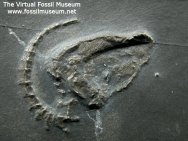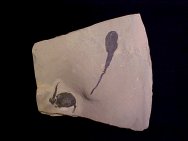Carpoid Stylophora Evolution
|
Evolutionary
Placement of the Enigmatic Carpoids |
Also see fossil
Carpoid examples: |
|
1)
They are very primitive echinoderms with a mobile stalk or single
arm filled with muscle;
 2)
Stylophorans are highly derived echinoderms related to crinoids
possessing an ambulacrum with tube-feet and an oral tegmen with
pharynx; and,
3)
They are neither primitive nor advanced echinoderms, but were
more
primitive chordates that
retained a calcite exoskeleton from an older common ancestor of
echinoderms and chordates, with the stalk
containing muscle, notochord and brain.
In a recent publication in Nature (Nature 438, 351-354; 2005), Clausen and Smith report evidence that support the first hypothesis and reject the last two, based on study of a ceratocystid stylophoran from the Middle Cambrian of Morocco. The weight of evidence now holds that the enigmatic carpoids are, indeed, primitive echinoderms and a stem group from the crinoids. Also see: Castericystis vali Cambrian Carpoid from Utah for another theory that carpoids are a common ancestor between echinoderms and vertebrates. |
||||||
Fossil
Museum Navigation:
Home Geological Time Paleobiology Geological History Tree of Life Fossil Sites Fossils Evolution Fossil Record Museum Fossils |

